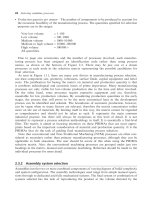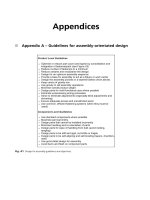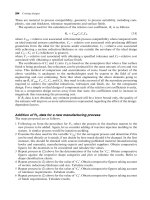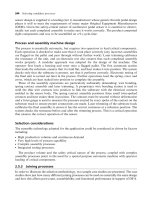Process Selection - From Design to Manufacture Episode 1 Part 7 ppt
Bạn đang xem bản rút gọn của tài liệu. Xem và tải ngay bản đầy đủ của tài liệu tại đây (616.62 KB, 20 trang )
//SYS21///INTEGRAS/B&H/PRS/FINALS_07-05-03/0750654376-CH002-1.3D – 104 – [35–248/214] 9.5.2003 2:05PM
.
Supply of lubrication (commonly phosphate based) to the die surfaces is important in providing
uniform material flow and reduce friction.
.
Small quantities of sulfur, lead, phosphorus, silicon, etc. reduce the ability of ferrous metals to
withstand cold working.
.
Surface cracking: tearing of the surface of the part, especially with high temperature alloys,
aluminum, zinc, magnesium. Control of the billet temperature, extrusion speed and friction are
important.
.
Pipe or fishtailing: metal flow tends to draw surface oxides and impurities towards center of part.
Governing factors are friction, temperature gradients and amount of surface impurities in billets.
.
Internal cracking or chevron cracking: similar to the necked region in a tensile test specimen.
Governing factors are the die angle and amount of impurities in the billet.
.
Surface detail is excellent.
.
Surface roughness ranging 0.1–1.6 mm Ra.
.
Process capability charts showing the achievable dimensional tolerances for impact extrusion and
cold forming are provided (see 3.4CC).
.
Dimensional tolerances for non-circular components are at least 50 per cent greater than those
shown on the charts.
104 Selecting candidate processes
//SYS21///INTEGRAS/B&H/PRS/FINALS_07-05-03/0750654376-CH002-1.3D – 105 – [35–248/214] 9.5.2003 2:05PM
3.4CC Cold forming process capability chart.
Cold forming 105
//SYS21///INTEGRAS/B&H/PRS/FINALS_07-05-03/0750654376-CH002-1.3D – 106 – [35–248/214] 9.5.2003 2:05PM
3.5 Cold heading
Process description
.
Wire form stock material is gripped in a die with usually one end protruding. The material is
subsequently formed (effectively upset) by successive blows into the desired shape by a punch
or a number of progressive punches. Shaping of the shank can be achieved simultaneously
(see 3.5F).
Materials
.
Suitable for all ductile metals: principally, carbon steels, aluminum, copper and lead alloys.
.
Alloy and stainless steels, zinc, magnesium, nickel alloys and precious metals are also processed.
Process variations
.
Usually performed with stock material at ambient temperature (cold), but also with stock material
warm or hot.
.
Solid die: single stroke, double stroke, three blow, two die, progressive bolt makers, cold or hot
formers – the choice is determined by the length to diameter ratio of the raw material.
.
Open die: parts made by this process have wide limits and are too long for solid dies.
.
Continuous rod or cut lengths of material can be supplied to the dies.
.
Can incorporate other forming processes, for example: knurling, thread rolling and bending to
produce complex parts at one machine.
.
Upset forging: heated metal stock gripped by dies and end pressed into desired shape, i.e.
increasing the diameter by reducing height.
3.5F Cold heading process.
106 Selecting candidate processes
//SYS21///INTEGRAS/B&H/PRS/FINALS_07-05-03/0750654376-CH002-1.3D – 107 – [35–248/214] 9.5.2003 2:05PM
Economic considerations
.
Production rates between 35 and 120/min common.
.
Lead times relatively short due to simple dies.
.
High material utilization. Virtually no waste.
.
Flexibility moderate. Tooling tends to be dedicated.
.
Production quantities typically very high, 100 000þ, but can be as low as 10 000.
.
Tooling costs moderate.
.
Equipment costs moderate.
.
Direct labor costs low. Process highly automated.
.
Finishing costs low: normally no finishing is required.
Typical applications
.
Electronic components
.
Electrical contacts
.
Nails
.
Bolts and screws
.
Pins
.
Small shafts
Design aspects
.
Complexity limited to simple cylindrical forms with high degree of symmetry.
.
Significant asymmetry difficult.
.
Minimization of shank diameter and upset volume important.
.
Radii should be as generous as possible.
.
Threads on fasteners should be rolled wherever possible.
.
Head volumes limited due to amount of deformation possible.
.
Inserts possible at added cost.
.
Undercuts produced via secondary operations.
.
Machining usually not required.
.
Draft angles not required.
.
Minimum diameter ¼ 10.8 mm.
.
Maximum diameter ¼ 150 mm.
.
Minimum length ¼ 1.5 m.
.
Maximum length ¼ 250 mm.
Quality issues
.
Cold working process gives improved mechanical properties.
.
Fatigue, impact and surface strength increased giving a tough, ductile, crack resistance structure.
.
Small quantities of sulfur, lead, phosphorus, silicon, etc. reduce the ability of ferrous metals to
withstand cold working.
.
Length to diameter ratio of protruding shank to be formed should be below 2:1 to avoid buckling.
.
Residual stresses may be left at critical points.
.
Sharp corners reduce tool life.
.
Surface detail is good to excellent.
Cold heading 107
//SYS21///INTEGRAS/B&H/PRS/FINALS_07-05-03/0750654376-CH002-1.3D – 108 – [35–248/214] 9.5.2003 2:05PM
.
Surface roughness ranging 0.8–6.3 mm Ra.
.
Process capability charts showing the achievable dimensional tolerances for cold heading are
provided (see 3.5CC).
3.5CC Cold heading process capability chart.
108 Selecting candidate processes
//SYS21///INTEGRAS/B&H/PRS/FINALS_07-05-03/0750654376-CH002-1.3D – 109 – [35–248/214] 9.5.2003 2:05PM
3.6 Swaging
Process description
.
Process of gradually shaping and reducing the cross section of tubes, rods and wire using succes-
sive blows from hard dies rotating around the material (on a mandrel if necessary for tubular
sections). Operation performed at ambient temperature (see 3.6F).
Materials
.
Carbon, low alloy and stainless steels, aluminum, magnesium, nickel and their alloys. Copper, zinc,
lead and their alloys less commonly.
Process variations
.
Using a shaped mandrel can generate inner section profiles different to outer.
.
Hand forging: hot material reduced, upset and shaped using hand tools and an anvil, commonly
associated with the blacksmith’s trade. For decorative and architectural work.
Economic considerations
.
Production rates moderate to high (100–300/h).
.
Lead time typically days depending on complexity of tool.
.
Special tooling not necessarily required for each job.
.
Material utilization excellent. No scrap generated.
.
Some automation possible.
.
Economical for low production runs. Can be used for one-offs.
.
Tooling costs high.
3.6F Swaging process.
Swaging 109
//SYS21///INTEGRAS/B&H/PRS/FINALS_07-05-03/0750654376-CH002-1.3D – 110 – [35–248/214] 9.5.2003 2:05PM
.
Equipment costs generally moderate.
.
Direct labor costs low to moderate.
Typical applications
.
Used to close tubes, produce tapering, clamping and steps in sections
.
Many section types possible either parallel or tapered
.
Tool shafts
.
Punches
.
Chisels
.
Handles
.
Exhaust pipes
.
Cable assemblies
.
Architectural work
Design aspects
.
Complexity fairly high. Round, square, rectangular and polygon sections possible either parallel or
tapered. Splines and contoured surfaces also possible.
.
Holes possible, but only through the length of the part.
.
No undercuts or inserts possible.
.
Draft angles ranging 0–3.5
.
.
Minimum section ¼ 2.5 mm.
.
Maximum section ¼ 50 mm.
.
Minimum solid diameter ¼ 12.5 mm.
.
Maximum solid diameter ¼ 1150 mm.
.
Maximum tube diameter ¼ 1350 mm.
.
Minimum length ¼ 1.5 mm.
.
Maximum length ¼ 250 mm.
Quality issues
.
Cold working of material gives good mechanical properties and compressive surface stresses
improve fatigue life.
.
Surface finish of stock material is markedly improved.
.
Surface detail is good to excellent.
.
Surface roughness values ranging 0.8–3.2 mm Ra.
.
A process capability chart showing the achievable dimensional tolerances for swaging is provided
(see 3.6CC).
110 Selecting candidate processes
//SYS21///INTEGRAS/B&H/PRS/FINALS_07-05-03/0750654376-CH002-1.3D – 111 – [35–248/214] 9.5.2003 2:05PM
3.6CC Swaging process capability chart.
Swaging 111
//SYS21///INTEGRAS/B&H/PRS/FINALS_07-05-03/0750654376-CH002-1.3D – 112 – [35–248/214] 9.5.2003 2:05PM
3.7 Superplastic forming
Process description
.
Sheet metal is clamped over a male or female form tool and heated to a high enough temperature to
give the material high ductility at low strain rates. Pressurized gas (typically argon) on the back face
of the sheet forms the material into cavity or over the surface of the tool (see 3.7F).
Materials
.
For stainless steels, aluminum and titanium alloys typically.
.
Material must be able to deform at low strain rates and high temperatures and possess a stable
microstructure.
Process variations
.
Either male or female tool: male forming is more complex, but offers greater design freedom and
more uniform material distribution.
.
Additional use of tool movement with gas pressure gives deeper parts with more uniform wall
thickness.
.
Diaphragm forming: uses additional diaphragm sheet behind material to give better control of
thickness distribution.
.
Can be used in conjunction with Diffusion Bonding (Welding) (DFW) to create complex parts
(see 7.9, Solid State Welding).
Economic considerations
.
Production rates low. Long cycle times.
.
Slower than conventional deep drawing.
3.7F Superplastic forming process.
112 Selecting candidate processes
//SYS21///INTEGRAS/B&H/PRS/FINALS_07-05-03/0750654376-CH002-1.3D – 113 – [35–248/214] 9.5.2003 2:05PM
.
Lead times moderate, typically weeks, depending on complexity of mold.
.
Material utilization good. Some waste may be generated during subsequent trimming operations.
Scrap not recyclable directly.
.
Some aspects can be automated.
.
Economically viable for low to moderate production volumes (10–10 000). Can be used for one-offs.
.
Tooling costs high.
.
Equipment costs high.
.
Direct labor costs low to moderate.
.
Finishing costs low to moderate. Trimming typically required.
Typical applications
.
Used to generate deep and intricate forms in sheet metal
.
Aerospace fuselage panels
.
Containers
.
Casings
.
Architectural and decorative work
.
Can also be used to clad other materials
Design aspects
.
Complexity limited to shape of female or male tool and constant thickness parts.
.
Ribs, bosses and recesses possible.
.
Re-entrant features not possible.
.
Radii should be greater than five times the wall thickness.
.
Sharp radii at extra cost can be produced.
.
Draft angles ranging 2 to 3
.
.
Maximum drawing ratio (height to width) ¼ 0.6.
.
Maximum dimension ¼ 2.5 m.
.
Maximum thickness ¼ 4 mm.
.
Minimum thickness ¼ 0.8 mm.
Quality issues
.
No spring back exhibited after processing.
.
No residual stresses.
.
Creep performance poor due to small grain sizes produced.
.
Cavitation and porosity can occur in some alloys at high temperatures and low strain rates.
.
Graphite coating on the blank sheet used to reduce friction.
.
Surface detail good.
.
Secondary operations such as heat treatment, paint, powder coating and anodizing commonly used
to improve finish.
.
Surface roughness ranging 0.4–6.3 mm Ra.
.
Achievable dimensional tolerances ranging Æ0.13 mm–Æ0.25 mm up to 25 mm, Æ0.45 mm–
Æ0.78 mm up to 150 mm. Wall thickness tolerances are typically Æ0.25 mm.
Superplastic forming 113
//SYS21///INTEGRAS/B&H/PRS/FINALS_07-05-03/0750654376-CH002-1.3D – 114 – [35–248/214] 9.5.2003 2:05PM
3.8 Sheet-metal shearing
Process description
.
Various shearing processes used to cut cold rolled sheet metal with hardened punch and die sets.
The most common shearing processes are: cutting, piercing, blanking and fine blanking (see 3.8F).
Materials
.
All ductile metals available in cold rolled sheet form, supplied flat or coiled.
.
Most commonly used metals are: carbon steels, low alloy steels, stainless steels, aluminum alloys
and copper alloys. Also, nickel, titanium, zinc and magnesium alloys are processed to a lesser
degree.
Process variations
.
Mechanical drives: faster action and more positive displacement control.
.
Hydraulic drives: greater forces and more flexibility.
.
Cutting: large sheets of metal are clamped and cut along a straight line.
.
Piercing: removal of material from a blank, for example, a hole.
.
Blanking: parts are blanked to obtain the final outside shape.
.
Fine blanking: uses special clamping tooling to produce a smooth and square-edged contoured
blank or hole.
.
Smooth wall hole piercing: special punch profiles are used to produce crack-free holes.
.
Other operations include: nibbling, notching, trimming and shaving.
.
Computer Numerical Control (CNC) common on piercing and blanking machines.
3.8F Sheet-metal shearing process.
114 Selecting candidate processes
//SYS21///INTEGRAS/B&H/PRS/FINALS_07-05-03/0750654376-CH002-1.3D – 115 – [35–248/214] 9.5.2003 2:05PM
Economic considerations
.
Production rates high, 10 000þ/h for small components.
.
High degree of automation possible.
.
Cycle time usually determined by loading and unloading times for stock material.
.
Progressive dies can incorporate shearing and forming processes.
.
Lead times can be several weeks depending on complexity and degree of automation, but more
typically, several days.
.
Material utilization moderate to high, however, substantial amounts of scrap can be produced in
piercing and blanking.
.
Production quantities should be high for dedicated tooling, 10 000þ. Economical quantities can
range from 1 for blanking and piercing to 2000 for fine blanking.
.
Tooling cost moderate to high, depending on process and degree of automation.
.
Equipment costs vary greatly. Low for simple guillotines to high for high speed, precision CNC presses.
.
Labor costs low to moderate depending on degree of automation.
.
Finishing costs low to moderate. Deburring and cleaning usually required.
Typical applications
.
Blanks for forming work
.
Cabinet panels
.
Domestic appliance components
.
Machine parts
.
Gears and levers
.
Washers
Design aspects
.
Complex patterns of contours and holes possible in two dimensions.
.
Material used dictates press forces and die clearances.
.
Blanked parts should be designed to make the most use of the stock material.
.
Pierced holes with their diameter greater than the material thickness should be drilled.
.
Fine blanked holes with diameters 60 per cent of the material thickness possible.
.
Holes should be spaced at least 1.5 times the thickness of the material away from each other.
.
Maximum sheet thickness ¼ 13 mm.
.
Minimum sheet thickness ¼ 0.1 mm.
.
Maximum sheet dimension for cutting is 3 m; 1 m for fine blanking.
Quality issues
.
Conventional hole piercing, blanking and cutting do not result in a perfectly smooth and parallel cut.
.
Acceptable hole wall and blank edge quality may be achieved with fine blanking and piercing processes.
.
Holes placed too close to a bend line can be distorted subsequently in forming operations.
.
Inspection and maintenance of die wear and breakage is important.
.
Variations in stock material thickness and flatness should be controlled.
.
Surface detail is good.
.
Surface roughness values ranging 0.1–12.5 mm Ra.
.
Process capability charts showing the achievable dimensional tolerances for several sheet-metal
shearing processes are provided (see 3.8CC).
Sheet-metal shearing 115
//SYS21///INTEGRAS/B&H/PRS/FINALS_07-05-03/0750654376-CH002-1.3D – 116 – [35–248/214] 9.5.2003 2:05PM
3.8CC Sheet-metal shearing process capability chart.
116 Selecting candidate processes
//SYS21///INTEGRAS/B&H/PRS/FINALS_07-05-03/0750654376-CH002-1.3D – 117 – [35–248/214] 9.5.2003 2:05PM
3.9 Sheet-metal forming
Process description
.
Various processes are used to form cold rolled sheet metal using die sets, formers, rollers, etc. The
most common processes are: deep drawing, bending, stretch forming and roll forming (see 3.9F).
Materials
.
All ductile metals available in cold rolled sheet form, supplied as blanks, flat or coiled.
.
Most commonly used metals are: carbon steels, low alloy steels, stainless steels, aluminum alloys and
copper alloys. Also, nickel, titanium, zinc and magnesium alloys are processed to a lesser degree.
.
Also coated materials, such as galvanized sheet steel.
Process variations
.
Mechanical drives: faster action and more positive displacement control.
.
Hydraulic drives: greater forces and more flexibility.
.
Deep drawing: forming of a blank into a closed cylindrical or rectangular shaped die. Incorporating
an ironing operation improves dimensional tolerances.
.
Bending: deformation about a linear axis to form an angled or contoured profile.
.
Stretch forming: sheet metal is clamped and stretched over a simple form tool.
.
Roll forming: forming of long lengths of sheet metal into complex profiles using a series of rolls.
.
Beading: edge of sheet bent into cavity of die. May be used to remove sharp edges.
.
Hemming: edge of sheet folded over. May be used to remove sharp edges.
.
Can incorporate initial sheet metal shearing operations.
3.9F Sheet-metal forming process.
Sheet-metal forming 117
//SYS21///INTEGRAS/B&H/PRS/FINALS_07-05-03/0750654376-CH002-1.3D – 118 – [35–248/214] 9.5.2003 2:05PM
Economic considerations
.
Production rates vary, up to 3000/h for small components using automated processes.
.
Deep drawing punch speeds a function of material; high to low – brass, aluminum, copper, zinc,
steel, stainless steel (typically 800/h).
.
High degree of automation is possible.
.
Cycle time is usually determined by loading and unloading times for the stock material.
.
Lead times vary, up to several weeks for deep drawing and stretch forming; could be less than an
hour for bending.
.
Material utilization is moderate to high (10–25 per cent scrap generated). Bending and roll forming
do not produce scrap directly. Deep drawing and stretch forming may require a trimming operation.
.
Production quantities should be high for dedicated tooling, 10 000þ. Minimum economical quantities
range from 1 for bending to 1000 for deep drawing.
.
Tooling cost is moderate to high, depending on component complexity.
.
Equipment costs vary greatly; low for simple bending machines, moderate for roll forming machines
and high for automated deep drawing, sheet metal presses and stretch forming.
.
Labor costs are low to moderate, depending on degree of automation.
.
Finishing costs are low. Trimming and cleaning may be required.
Typical applications
.
Cabinets
.
Mounting brackets
.
Electrical fittings
.
Cans
.
Machine frames
.
Automotive body panels
.
Aircraft fuselage panels
.
Light structural sections
.
Domestic appliances
.
Kitchen utensils
Design aspects
.
Complex forms possible: several processes may be combined to produce one component, or a
series of operations used to progressively form the part.
.
Working envelope of machine and uniform thickness of sheet can restrict design options.
.
No inserts or re-entrant angles.
.
Draft angles maybe required (0.25
).
.
Minimum bend radii are a function of material and sheet thickness, but typically four times the sheet
thickness.
.
Radii kept as large as possible, particularly if parallel with grain of material.
.
Square or rectangular boxes limited by sharpness of corner detail required.
.
Minimum sheet thickness ¼ 0.1 mm.
.
Maximum sheet thickness: deep drawing ¼ 12 mm, bending ¼ 25 mm, roll/stretch forming ¼ 6 mm.
.
Sizes ranging 12–1600 mm for deep drawing; 10 mm–1.5 m width for roll forming; 2 mm–3.6 m
width for bending.
118 Selecting candidate processes
//SYS21///INTEGRAS/B&H/PRS/FINALS_07-05-03/0750654376-CH002-1.3D – 119 – [35–248/214] 9.5.2003 2:05PM
Quality issues
.
Bending and stretch forming are limited by the onset of necking.
.
The limiting drawing ratio (blank diameter/punch diameter) is between 1.6 and 2.2 for most materi-
als. This should be observed where drawing takes place without progressive dies, otherwise
excessive thinning and tearing could occur.
.
Variations in stock material thickness and flatness should be controlled.
.
Other problems include: spring-back (metal returns to original form) and wrinkling during drawing
(comparable with forcing a circular piece of paper into a drinking glass), eliminated by adjustment of
blank holder force.
.
Spring-back can also be compensated for by over-bending, coining and stretch-bending operations.
.
High residual stresses can be generated. Subsequent heat treatment may be necessary.
.
Surface detail is good.
.
Surface roughness is approximately that of the sheet-material used.
.
Process capability charts showing the achievable dimensional tolerances are provided (see 3.9CC).
Sheet-metal forming 119
//SYS21///INTEGRAS/B&H/PRS/FINALS_07-05-03/0750654376-CH002-1.3D – 120 – [35–248/214] 9.5.2003 2:05PM
3.9CC Sheet-metal forming process capability chart.
120 Selecting candidate processes
//SYS21///INTEGRAS/B&H/PRS/FINALS_07-05-03/0750654376-CH002-1.3D – 121 – [35–248/214] 9.5.2003 2:05PM
3.10 Spinning
Process description
.
Forming of sheet-metal or thin tubular sections using a roller or tool to impart sufficient pressure for
deformation against a mandrel while the work rotates (see 3.10F).
Materials
.
All ductile metals that are available in sheet form. The most common metals used are carbon steels,
stainless steels, aluminum alloys, copper alloys and zinc alloys.
.
Used on a more limited basis are: magnesium, tin, lead, titanium and nickel alloys.
Process variations
.
Tube spinning: thickness reduction of a cylindrical section on a mandrel, either internally or
externally.
.
Flame spinning: oxyacetylene flame heats material prior to forming. Permits rapid forming of parts
with thick sections.
.
Shear spinning: point extrusion process reduces thickness of starting blank or shape to produce the
final form.
Economic considerations
.
Production rates are low, typically 10–30/h.
.
Lead times are short. Simple mandrels made quickly.
3.10F Spinning process.
Spinning 121
//SYS21///INTEGRAS/B&H/PRS/FINALS_07-05-03/0750654376-CH002-1.3D – 122 – [35–248/214] 9.5.2003 2:05PM
.
Material utilization is moderate. Main losses occur in cutting blanks.
.
Flexibility is high: formers are changed quickly and setup times are low.
.
Production volumes are viable from 10 to 10 000. Can be used for one-offs.
.
Tooling costs are low.
.
Equipment costs are moderate.
.
Labor costs are high. Skilled labor is needed.
.
Finishing costs are low. Cleaning and trimming required.
Typical applications
.
Flanged, dished, spherical and conical shapes
.
Nose cones
.
Missile heads
.
Bells
.
Light shades
.
Cooking utensils
.
Funnels
.
Reflectors
Design aspects
.
Complexity is limited to thin-walled, conical, concentric shapes. Typically, the diameter is twice the
depth.
.
Cylindrical or cup-shaped pieces are the most difficult of the simple shapes.
.
Oval or elliptical parts are possible, but expensive.
.
Material thickness, bend radii, depth of spinning, diameter, steps in diameter and workability of the
material are important issues in spinning.
.
Radii should be at least 1.5 times the material thickness.
.
Stiffening beads should be formed externally rather than internally.
.
No draft angle is required.
.
Undercuts are possible, but at added cost.
.
Maximum section is 75 mm for automated spinning, but approximately 6 mm for hand spinning.
.
Minimum section ¼ 0.1 mm.
.
Sizes ranging 16 mm–17.5 m.
Quality issues
.
Skill and experience are required to cause the metal to flow at the proper rate avoiding wrinkles and
tears.
.
Streamlined or smooth curves and large radii are an aid both to manufacture and improved
appearance.
.
Associated problems are blank development and proper feed pressure.
.
Grain flow and cold working give good mechanical properties.
.
Surface detail is good.
.
Surface roughness ranging 0.4–3.2 mm Ra.
.
A process capability chart showing the achievable dimensional tolerances is provided (see
3.10CC).
122 Selecting candidate processes
//SYS21///INTEGRAS/B&H/PRS/FINALS_07-05-03/0750654376-CH002-1.3D – 123 – [35–248/214] 9.5.2003 2:05PM
3.10CC Spinning process capability chart.
Spinning 123









